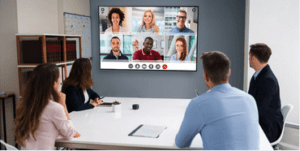Table of Contents
Share
Back when everyone first started working from home because of COVID-19, the Internet proclaimed, “Now we’ll finally see which meetings could have been emails!” Months later, some telecommuters might now find the joke a lot less funny. As workers and managers have increasingly collaborated online instead of in-person, meetings may have actually become more frequent. Virtual meeting fatigue has become a serious new challenge for companies trying to keep pace with the changing demands of a remote workforce.
What is virtual meeting fatigue?
Increasingly common with so many people working from home, virtual (or video/Zoom) meeting fatigue causes physical and psychological strain for employees meeting regularly in video conferences. Without the need to reserve a room at the office, video meetings are easy to schedule. Unfortunately, the excessive number of online meetings can lead to anxiety and emotional exhaustion, even for extroverted employees who would enjoy frequent collaboration in-person.
How does it affect workers?
Part of the anxiety comes from the absence of social cues that might be subconscious in person. It’s harder to read body language and gestures when nothing below the shoulders might be visible. When glitches and connection issues occur, it can be unclear whether everyone is having the same difficulty or whether you misheard what was said. We’re accustomed to looking into each other’s eyes frequently during a conversation, but it feels like an endless staring contest when everyone has cameras positioned directly above their monitors. At the same time, employees may feel exposed by giving coworkers a glimpse inside their homes, potentially with children or family members passing by.
Check out these helpful tips and share with your employees to help minimize video meeting fatigue:
Cut unnecessary meetings
Back in the office, you wouldn’t want employees to be booked for endless meetings all day, so limit the number and duration of virtual meetings as well. Help your managers evaluate how they communicate with remote employees, and identify which meetings really “could have been an email.” Online meetings feel less disruptive since employees remain seated at their computers, but there’s still a need for preparation before each meeting and action items afterward.
Avoid back-to-back virtual meetings
In addition to preparing for the next meeting, employees need a few minutes to cool down and collect themselves. Suggest that employees use the time for stretching, bathroom breaks, and getting out of their chairs. With consecutive meetings, employees will be more tempted to multitask to avoid falling behind on work. If they’re working and answering emails during the meeting, then they’re not giving their full attention to the meeting or their work. When employees are multitasking, they’re slower to respond to questions, making unnecessary meetings even longer and more frustrating.
Schedule breaks for longer meetings
Some tasks and projects inevitably require longer meetings. As with back-to-back meetings, there’s a limit to how long your employees can pay full attention while staring at screens. No matter how many shows you can binge-watch on Netflix, meetings require active listening and engagement. When you include breaks, participants can get snacks and maybe even step outside. Unlike the office, your employees have a lot of space to relax and they need a few minutes to get away from the computer.
Set an agenda and stick to it
Without remote team management skills, some leaders find it easier to keep in-person meetings on track. An agenda is vital for video meetings because participants have browser tabs and chat windows full of potential distractions. When everyone knows the list of talking points and the time available, it’s easier to divide the time appropriately between agenda items.
Change up your workstation and camera angle
Staying in the same seat for hours can get exhausting, and some employees may not have the ergonomic chairs available at the office. If employees are working full days from their sofas and beds, then you may help them invest in home office equipment as part of your benefits package for remote employees. Even if they have adequate desks and chairs, employees may get a fresh perspective by moving around. External webcams can also be positioned off to one side, ending the competitive staring contest that’s common with permanent cameras mounted directly above the screen.
Make being on-camera optional
It’s good for team leaders to maintain a rapport with employees, and occasional video conferences can give useful hints about employee well-being. Still, being on-camera can create an unnecessary burden for employees who would require 20 minutes or more to change clothes and make their appearance presentable. Remote workers may have a habit of working in their pajamas, which means that preparing for a video call would disrupt their routine. Depending on which software your company uses for video conferencing, your employees should also be able to use digital backgrounds to avoid showing the inside of their homes. Like decorating a cubicle or office space, custom backgrounds allow employees to show their individual personalities and build rapport.
Find what display setting works best for you
Depending on the number of active presenters in a meeting and other variables, you may find the grid or pop-up display more natural. The grid allows you to see nods and gestures from other people who want to interject, but a larger display of the speaker is useful for meetings with less collaboration.
When remote workers are informed about the issue of virtual meeting fatigue, they’re better equipped to prevent this unexpected source of burnout. Additional simple work from home tips can improve the emotional wellness and work performance of your remote teams.
Related articles

Finding the Balance: How to Create a Hybrid Work Environment

What is Hybrid Work? And How Can It Benefit Your Company?

What Is ‘Windowed Work’ and Why It Could Be the Key to Your Remote Work Success

